In this tutorial you will learn how to write a biographical essay – an essay about a person.
This method will work for writing about anyone:
- Yourself
- Your friend or a loved one
- A public or historical figure
- Anyone else you respect and admire.
How to Structure a Biographical Essay
The biggest challenge in writing a biography essay is coming up with material. And the easiest way to keep your ideas flowing is to break your topic into subtopics.
Do you recall the saying, “Divide and conquer?” This military concept states that in order to conquer a nation, you must divide it first.
We’ll use this idea in our approach to writing about a person. Remember, a person, a human being is our main subject in a biographical essay.
And to discuss a person effectively, we must “divide” him or her.
How would we go about dividing our subject into subtopics?
The Power of Three
The easiest way to break up any subject or any topic is to use the Power of Three.

When you have just one subject, undivided, that’s a recipe for being stuck. Dividing into two is progress.
But three main supporting ideas, which correspond to three main sections of your essay, are the perfect number that always works.
Note that the three supporting points should also be reflected in your thesis statement.
Let’s see how it would work when talking about a person.
What does any person have? What are the aspects of any human being?
Any person has emotions.
In fact, humans are very emotional creatures. This part deals with how the person feels.
This section or part of the essay will answer some of the following questions:
“How emotional is this person in her decision making?”
“What emotions predominate in this person? Is this person predominantly positive or negative? Calm or passionate?”
You can discuss more than one emotion with regards to this person.
Any person has an intellect.
The intellect is the ability to think rather than feel. This is an important difference.
Something that is very important to remember when dividing your topic into subtopics is to make sure that each subtopic is different from the others.
Thinking is definitely different from feeling, although they are related because they are both parts of human psychology.
This part of the essay will answer the questions:
“How smart is this person?”
“How is this person’s decision making affected by her intellect or logic?”
“What intellectual endeavors does this person pursue?”
Any person has a body, a physicality.
This sounds obvious, but this is an important aspect of any human being about whom you choose to write.
This part of your essay answers these questions:
“What are this person’s physical attributes or qualities?”
“How do this person’s physical qualities affect her and others?”
“How do they affect her life?”
“Is this person primarily healthy or not?”
And there are many more questions you can ask about this person’s physicality or physical body.
As a result of dividing our subject into three distinct parts, we now have a clear picture of the main structure of this essay.
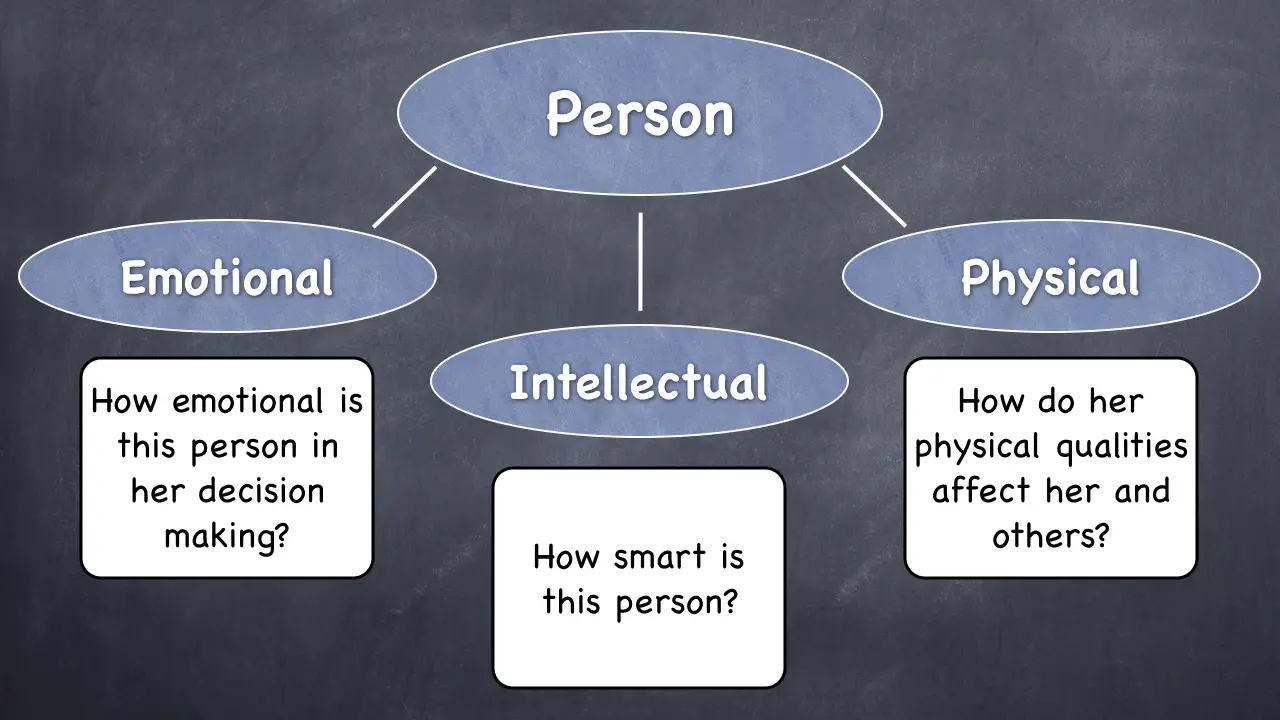
Another Way to Divide a Subject – Change
Another great way to talk about a person is to discuss a change, any kind of a change.
Change as an idea lends itself very well to the Power of Three because it involves three parts.
Think of a person who has lost weight, for example. What are the three parts of that change?
First, it’s how much the person weighed in the past, before the change. Second, it is the agent of change, such as an exercise program. And third, it is the result; it’s how much the person weighs after the change has happened.
This structure is applicable to any kind of a change.
The Past
In this part of the essay, you can discuss anything that is relevant to the way things were before the change took place. It’s the “before” picture.
Some of the questions to ask are:
“How did this person use to be in the past?”
“How did the old state of things affect her life?”
The Agent of Change
This can be anything that brought about the change. In the case of weight loss, this could be a diet or an exercise program. In the case of education, this could be college.
Some of the question to ask are the following:
“What happened? What are the events or factors that made this person change?”
“What actually brought about the change in this person?”
Maybe the person went to college, and college life changed this person.
Maybe this person went to prison. That can change a person’s life for the better or worse.
Maybe she underwent some interesting sort of a transformation, such as childbirth or a passing of a loved one. It could even be a car accident or some other serious health hazard.
The Present
This is the “after” picture. In this section, you would describe the state of this person after the change has taken place.
This part of the essay would answer the questions:
“How is this person now?”
“What has changed?”
Note that the resulting change doesn’t have to be set in the present day. This change could have happened to a historical figure, and both the “before” and “after” would be in the past.
And there you have it. You have three parts or three sections, based on some kind of a change.
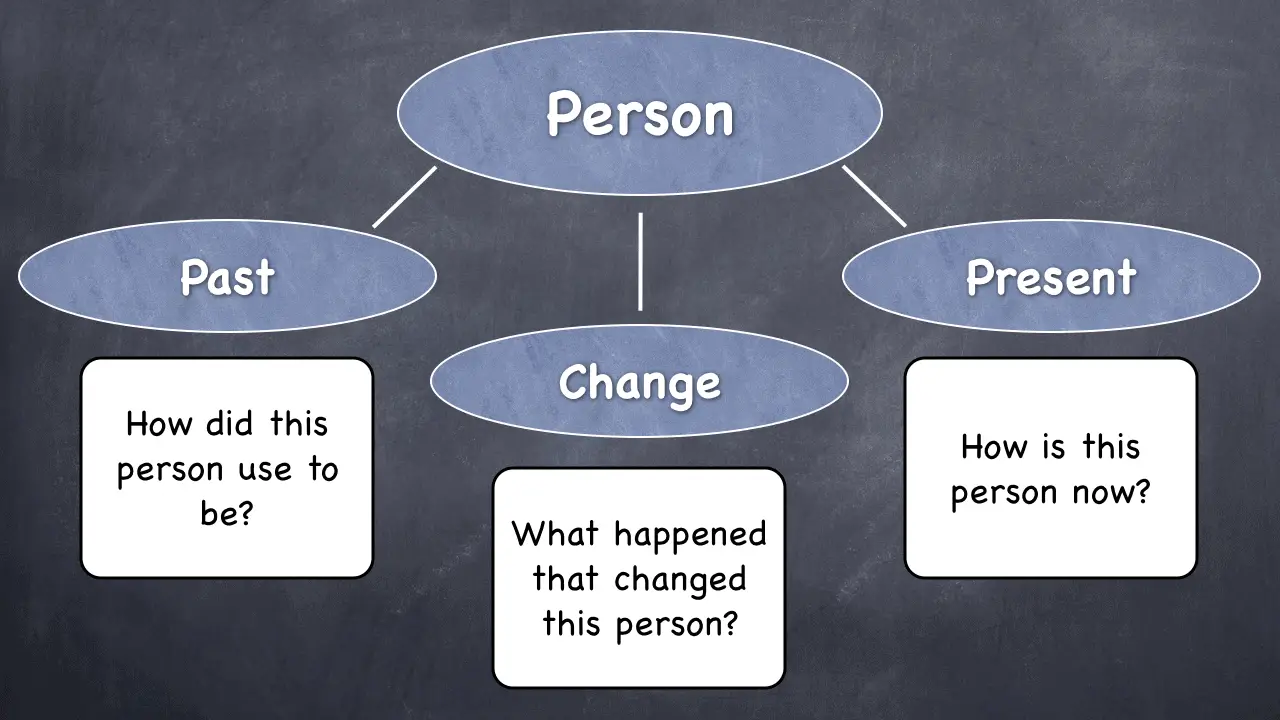
This is a wonderful way to discuss any person, especially if you’re writing a biography of a public or historical figure.
A Third Way to Divide a Subject – Personal Qualities
A great way to discuss a person, especially someone you know personally, is to talk about their qualities of character.
A person can have many character qualities. And in this case, the Power of Three helps you narrow them down to three of the most prominent ones.
Let’s pick three personal qualities of someone you might know personally.
Courage
In this section, you could simply provide examples of this person showing courage in times of trouble.
Ambition
Here, you would talk about the goals and dreams this person has and how she plans to achieve them.
Kindness
Here, just provide examples of acts of kindness performed by this person.
Three major qualities like these are enough to paint a pretty thorough picture of a person.
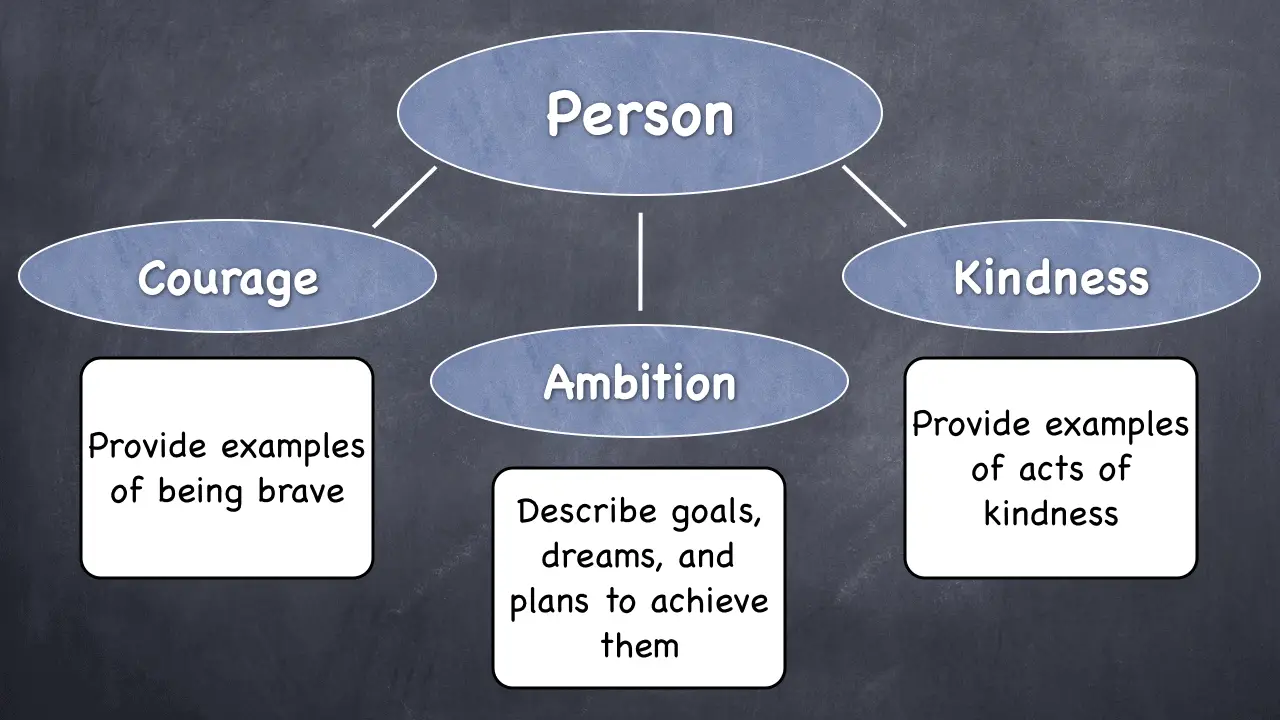
Discussing personal qualities is a great way to add content to your biographical essay. And it works in a discussion of any human being, from a friend to a distant historical figure.
How to Write a Longer Biography Essay
At this point, you have all the building blocks to write an excellent essay about a person.
By the way, if you struggle with essay writing in general, I wrote a detailed guide to essay writing for beginners.
In this section, I want to show you how to use what you’ve learned to construct one of those big papers, if that’s what you need to do.
If you have to write a basic essay of about 600-1000 words, then just use one of the simple structures above.
However, if you need to write 2,000 – 5,000 words, or even more, then you need a deeper structure.
To create a deeper, more complex structure of a biography essay while still keeping the process easy to follow, we’ll simply combine structures we have already learned.
Combining Change and Human Attributes
Let’s say that you decided that your main point will be about this person’s change as a result of some event.
Then, you will have three main sections, just like I showed you in writing about any change.
In effect, you will be discussing:
- How this person was in the past (before the change)
- The actual change
- What happened as the result
You now have divided your essay into three parts. And now, you can use the Power of Three again to divide each main section into subsections.
Section 1. You can talk about how this person was in the past, in terms of:
- Emotions
- Intellect
- Physicality
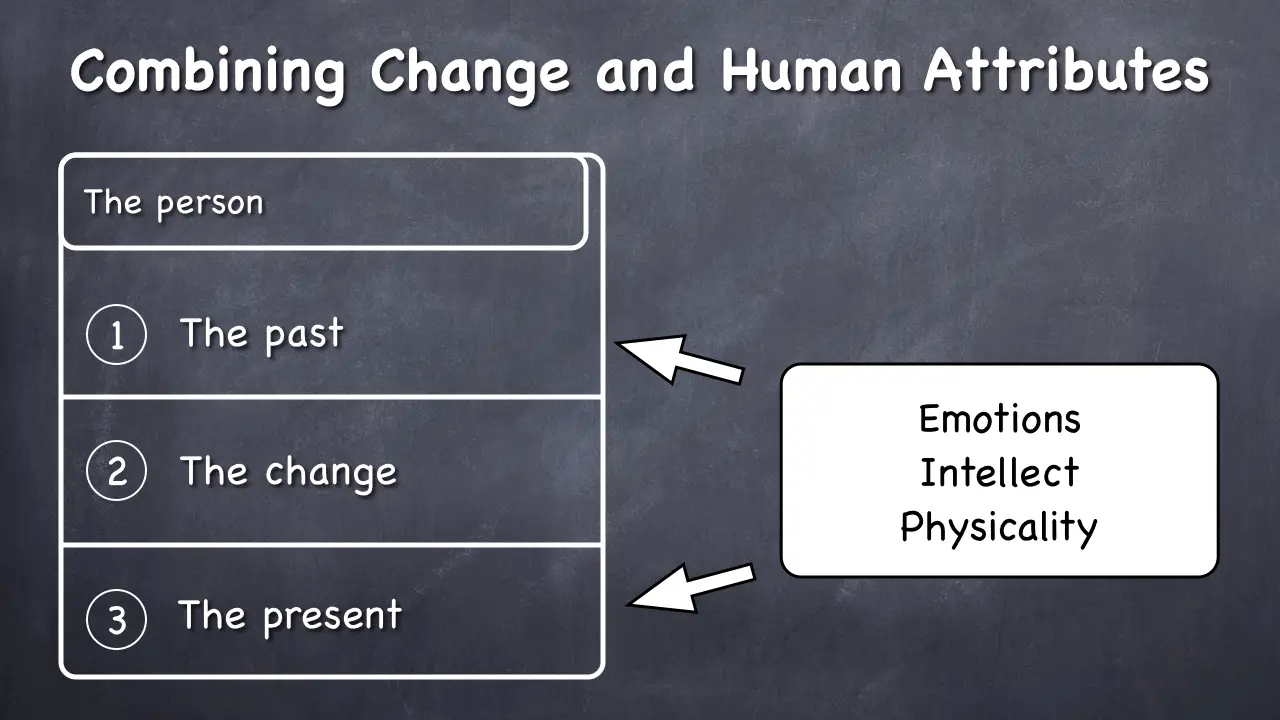
Section 2. When you talk about change, you can still use the Power of Three.
You can ask the question, “What were the drivers of change?”
You can be even more specific here and ask, “What were the three drivers of change?”
And then you answer that question.
For example, if this person went to college, some of the factors of change could have been:
- Peers
- Professors
- The pressure of having to submit work on time.
And those factors changed this person.
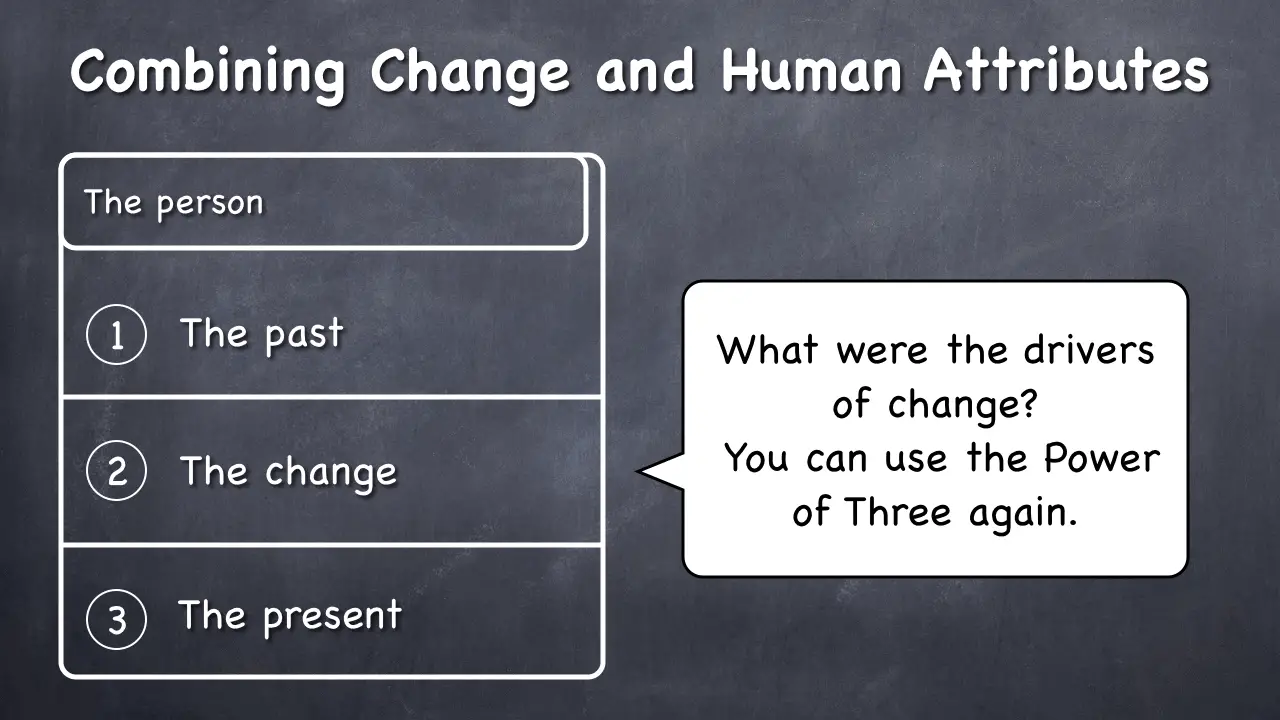
Section 3. As a result of the change, how is this person now, in terms of:
- Emotions
- Intellect
- Physicality
Other Ways to “Divide and Conquer”
Note that there are many more aspects of any person that you can discuss.
Some of them include:
- Outer vs Inner life.
- Personal vs Professional life.
- Abilities or Skills.
You can pick any other aspects you can think of. And you can use the Power of Three in any of your sections or subsections to write as much or as little as you need.
Tips on Writing a Biographical Essay
You can apply any of these techniques to writing about yourself.
When you’re writing about yourself, that’s an autobiographical essay. It is simply a piece of writing in which you reveal something about your life.
You can take any of the ways we just used to divide a human being or her life into parts and apply them to yourself.
This can work in a personal statement or a college admissions essay very well.
Here’s a list of things to narrow your autobiographical essay topic:
- One significant event in your life
- A change that you decided to make
- A person you met who changed your life (or more than one person)
- The biggest lesson you’ve ever received in life
- Your goals and aspirations (talking about the future)
Structure your essay as if it is an argumentative essay.
Most of the research papers and essays you’ve written up to date have probably been expository. This means that you stated an argument and supported it using evidence.
A biographical essay is not necessarily expository. You don’t always have something to argue or prove. You could simply tell the reader a story about yourself or describe a period in your life.
But you can and probably should still use the structures presented in this tutorial because this will make it much easier for you to organize your thoughts.
Stay focused on your subject.
Once you know your structure, just stick to it. For example, if you’ve chosen to talk about a person’s courage, ambition, and kindness, these three qualities will carry your essay as far as you want.
But don’t sneak in another quality here and there, because that will dilute your argument. Be especially careful not to write anything that contradicts your view of this person.
If you use contradictory information, make sure it is a counterargument, which is a great technique to add content. You can learn how to use counterarguments in this video:
Hope this helps. Now go write that biography essay!
Tutor Phil
